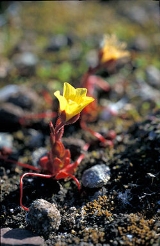
Saxifraga flagellaris
Encyclopedia
- This article is about the Saxifraga flagellaris as described by WilldenowCarl Ludwig WilldenowCarl Ludwig Willdenow was a German botanist, pharmacist, and plant taxonomist. He is considered one of the founders of phytogeography, the study of the geographic distribution of plants...
. Other authors often used the name for Saxifraga platysepala (Broadsepal Saxifrage).
Saxifraga flagellaris (Whiplash Saxifrage) is a plant native all over the high arctic and some areas of northern Rocky Mountains
Rocky Mountains
The Rocky Mountains are a major mountain range in western North America. The Rocky Mountains stretch more than from the northernmost part of British Columbia, in western Canada, to New Mexico, in the southwestern United States...
, and Norway
Norway
Norway , officially the Kingdom of Norway, is a Nordic unitary constitutional monarchy whose territory comprises the western portion of the Scandinavian Peninsula, Jan Mayen, and the Arctic archipelago of Svalbard and Bouvet Island. Norway has a total area of and a population of about 4.9 million...
. It is not very common. It is also known as Spider Saxifrage or "spider plant", though the latter name more commonly refers to the unrelated Chlorophytum comosum
Chlorophytum comosum
Chlorophytum comosum, often called the spider plant, is a herbaceous plant. It is native to tropical and southern Africa, but has become naturalized in other parts of the world, including western Australia. Variegated forms in particular are used as house plants.-Description:Chlorophytum comosum...
(Agavaceae
Agavaceae
Agavoideae is a subfamily of monocot flowering plants in the family Asparagaceae, order Asparagales. It has previously been treated as a separate family, Agavaceae. The group includes many well-known desert and dry zone types such as the agave, yucca, and Joshua tree...
). The Broadsepal Saxifrage (S. platysepala) was formerly included in the present species.
The stems are single, erect and leafy, growing to 3–10 cm tall. The basal leaves
Leaf
A leaf is an organ of a vascular plant, as defined in botanical terms, and in particular in plant morphology. Foliage is a mass noun that refers to leaves as a feature of plants....
in a dense rosette
Rosette (botany)
In botany, a rosette is a circular arrangement of leaves, with all the leaves at a single height.Though rosettes usually sit near the soil, their structure is an example of a modified stem.-Function:...
from which long, filiform runners radiate ending in a small, rooting offset; they also have glandular hairs on the margins. Each stem usually has one terminal flower
Flower
A flower, sometimes known as a bloom or blossom, is the reproductive structure found in flowering plants . The biological function of a flower is to effect reproduction, usually by providing a mechanism for the union of sperm with eggs...
, rarely two, with golden yellow petals, much longer than the calyx lobes. The whole plant is more or less red. It grows in moist places, on gravel or in moss carpets.
It is not in any danger of extinction, but is yet very rare.

